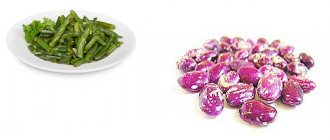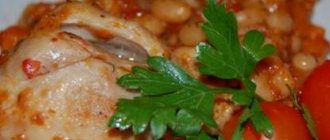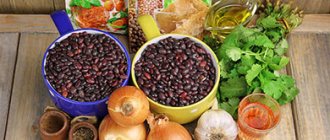Chemical composition of red beans
Red beans contain all the beneficial vitamin and mineral complexes necessary for the full functioning of the body.
Content of macro- and microelements per 100 g of product based on the percentage of recommended daily requirement (RDR)
| Microelements | mg | RSP, % | Potassium, K | 403 | 16 |
| Calcium, Ca | 28 | 3 | Magnesium, Mg | 45 | 11 |
| Sodium, Na | 238 | 18 | Phosphorus, P | 142 | 18 |
| Microelements | Iron, Fe | 2.94 | 16 | ||
| Manganese, Mn | 0.48 | 24 | Copper, Cu | 0.24 | 24 |
| Selenium, Se | 1.2 | 2 | Zinc, Zn | 1.07 | 9 |
Content of vitamins per 100 g of product based on RSP
| Vitamin K | 8.4 mcg | 7% |
| Vitamin B1, Thiamine | 0.16 mg | 11% |
| Vitamin PP, NE | 2.29 mg | 11% |
| Vitamin PP, Niacin | 0.58 mg | 3% |
| B vitamins | ||
| Vitamin B2, Riboflavin | 0.06 mg | 3% |
| Vitamin B4, Choline | 30.5 mg | 6% |
| Vitamin B5, Pantothenic acid | 0.22 mg | 4% |
| Vitamin B6, Pyridoxine | 0.12 mg | 6% |
The benefits of B vitamins are manifested in cellular metabolism, strengthened immunity, healthy skin and hair.
Vitamin PP and nicotinic acid contribute to the absorption of red bean protein and ensure the health of the nervous and cardiovascular systems, strengthening visual acuity.
In addition, red beans are a rich source of essential amino acids:
| Arginine | 0.54 g | Valin | 0.45g | 24% | |
| Histidine | 0.24 g | 22% | Isoleucine | 0.38 g | 25% |
| Leucine | 0.69 g | 21% | Lysine | 0.6 g | 19% |
| Methionine+Cysteine | 0.22 g | 15% | Threonine | 0.37 g | 23% |
| Tryptophan | 0.1 g | 25% | Phenylalanine+Tyrosine | 0.71 g | 25% |
Tryptophan – has pronounced sedative properties, helping to overcome depression, normalizing sleep and tension.
Arginine – supports the reproductive sphere and is part of collagen, providing skin elasticity.
Lysine – protects against harm from viruses and infections, protects against cancer.
Tyrosine is useful in regulating the endocrine system, works as an antioxidant and antidepressant, and reduces the likelihood of allergic reactions.
Histidine is part of hemoglobin and helps with anemia.
Nutritional value and calorie content of red beans
Red beans are rich in high-quality, easily digestible protein, equal to the benefits of meat and fish proteins.
The energy value of 100 g of product is: 127 kcal - this is 6% of the RSP.
Nutrients
| Carbohydrates | 15.4 g | 5% |
| Fats | 0.5 g | 1% |
| Squirrels | 8.67 g | 14% |
| Alimentary fiber | 7.4 g | 37% |
| Cholesterol | 0 mg | 0% |
One glass of beans contains the daily requirement of soft fiber, which, in combination with complex carbohydrates, exhibits the properties of quickly saturating the body, maintaining a feeling of fullness and providing the body with energy for a long time, as well as cleansing of toxins and helping in the prevention of tumors.
The benefits of red beans for the body
The beneficial properties of beans lie mainly in their high nutritional value, which can rival those of animal products.
In addition to high antioxidant properties, red beans have a number of benefits:
- Vitamins B1 and B6 ensure the stability of the immune system and protect the body from the effects of viruses. In addition, vitamin B1 stimulates metabolism and the functioning of the nervous system, providing the body with stress resistance.
- The product is able to improve digestion due to the development of beneficial intestinal microflora with the help of dietary fiber, a particularly high amount of which is contained in bean skins. Therefore, they are indicated for constipation problems.
- A high percentage of fiber content gives a laxative effect on the intestines and also helps cleanse the body of harmful waste, toxins, heavy metals, cholesterol, which, in turn, helps prevent atherosclerosis.
- The benefit of red bean fiber is its ability, with the help of intestinal bacteria, to participate in the creation of short-chain fatty acids, which become a source of energy so necessary for men, athletes and people whose activities are associated with physical activity, as well as those undergoing a rehabilitation period after illness.
- Choline regulates lipid metabolism in the liver and helps relieve inflammatory processes in this body filter.
- The benefits of red beans to regulate acidity in the body are indicated for people with gastrointestinal problems, as well as excess weight.
- The diuretic properties of beans help remove stones from the kidneys and gall bladder, and eliminate infections in the urinary system.
- Red beans are indispensable in the diabetic menu - thanks to arginine, which can effectively lower blood glucose levels.
- The calcium and potassium content gives the product useful properties to normalize the functioning of the cardiovascular system, regulate blood pressure, and cope with hypertension at different stages.
- Folic acid contained in beans can reduce homocysteine in the blood that disrupts the functioning of blood vessels, promote the process of hematopoiesis and, in combination with iron, prevent the harm of anemia, as well as supply tissues and organs with oxygen.
- Red beans are also indicated for muscle spasms: they have the power to reduce their severity.
- Red beans are also highly valued in cosmetology due to their beneficial properties of regenerating the skin, increasing its elasticity and coping with anti-aging changes.
Beneficial properties of red beans
General benefit
Rich in a full range of vitamins and microelements, beans can be considered a complete basic dish in the diet, providing the body with all the necessary amino acids and beneficial compounds.
It completely replaces meat, fish and egg products in the diet of vegetarians, during fasting and diets. This helps to significantly relieve the body, because it takes less energy to digest beans. Beans are easily digestible and help burn excess fat. Among the valuable properties of red bean varieties:
- Comprehensive cleansing of the body, stimulation of kidney function and removal of excess fluid, getting rid of toxins.
- Stimulates heart function, strengthens muscle tissue and blood vessel walls, increases skin elasticity and accelerates regeneration processes.
- Antioxidant and rejuvenating effect, normalization of metabolic processes, control of appetite and hormonal balance.
- Strengthening the nervous system, normalizing the sleep cycle, getting rid of chronic fatigue and depression, increased anxiety and inhibiting the development of degenerative disorders.
- Participation in hematopoiesis, increasing the level of red blood cells.
- Formation of healthy immunity and increasing the body's defenses.
- Anti-inflammatory effect, especially in relation to the pelvic organs: excretory and reproductive systems - prevention of male diseases.
- Reducing cholesterol and blood sugar levels, normalizing blood pressure.
- Treatment of skin diseases, including fungal and bacterial ones, elimination of dandruff and otomycosis.
- Supporting the body during infertility treatment.
The main properties of beans are considered to saturate the blood, protect the cardiovascular system, as well as a natural sedative effect. Therefore, it is indispensable in the diet in late autumn, with the onset of cold weather, and in spring, after prolonged winter stress. It helps strengthen the body and replenish nutrients; in addition, it saves you from stress overeating, filling you up for the whole day and fighting off cravings for sweets.
We recommend reading:
benefits and harms of chickpeas
Read
For women
Women really appreciate the rejuvenating properties of beans. It can cleanse the skin of rashes, normalize complexion, and eliminate signs of fatigue. In addition, it lifts your mood, stabilizes your emotional background, increases libido, and relieves tension. This is especially true during menopause and after menopause.
Red beans also stimulate fertility and increase the chances of pregnancy in people with problems in this area. Beans not only protect against inflammation and normalize hormone production, but also prepare a woman’s body for bearing a fetus by supplying it with folic acid.
The fruits of beans promote easy weight loss, increase the tone and endurance of the body, therefore they are useful for training in the gym and fitness classes. Beans quickly satisfy your hunger and allow you not to think about snacking, making it easier not only to lose weight, but also to get rid of bad habits.
For men
For the stronger sex, beans will help protect against heart disease and reduce the risk of heart attack or the development of atherosclerosis. It is also good for preventing impotence and prostate diseases. The zinc in beans promotes the production of healthy seminal fluid and sufficient testosterone. Calcium, iron and vitamins help increase potency and sexual stamina.
For athletes, beans help maintain normal water balance in the body, sweat easily and replenish salt composition. The components of the red bean product increase endurance during strength training and help restore strength faster.
For teenagers, adding beans to their diet will help them go through the transition period and changes in the body more smoothly, relieve acne and increased excitability, and promote the formation of muscle mass.
For children
Since ripe beans are a rather dense product, and legume proteins sometimes cause allergic reactions, the child’s body should be accustomed to the new component gradually and monitored for rashes and intestinal disorders.
Beans are introduced after 2 years. While the baby is not feeding independently, it must be mashed into purees and added a spoonful to the main dishes. Over time, the portion can be increased. Beans are not given at the same time as animal proteins: meat, eggs - or bread products, cereals. You can give your child beans 2-3 times a week.
In preschool and school age, children are offered full portions of “meat substitute”, but not more than 3 times a week, alternating with other food products. If a child willingly eats beans and asks for them more often, it is worth checking the baby for magnesium or iron deficiency and supplementing the diet with greens: broccoli, spinach, nuts. If you are anemic, you can feed your child beans regularly, for example 5 times a week, until the iron level increases. Afterwards, be sure to take a break.
There should not be a lot of beans in a child's diet: its components can irritate the stomach, and in children the mucous membrane is still very sensitive. In addition, in childhood, proteins and calcium from plant foods must be supplemented with dairy products and alternated with them.
When losing weight
The reason to lose a few kilograms can be not only the desire to be slim, but also medical indications. For example, with diabetes or heart disease, excess weight significantly overloads the body. This is where beans come to the rescue, as they can completely replace cholesterol-containing foods: meat, eggs, oils.
Due to the content of dietary fiber, beans cleanse the intestines and remove toxins, thereby improving the absorption of nutrients, normalizing metabolism and well-being. On a bean diet, you may feel discomfort at first while the body cleanses and rebuilds. However, after 3-5 days you can feel lightness, increased endurance and performance, strengthening of the nervous system and stabilization of internal processes: regular bowel movements, normal appetite, falling asleep quickly, reduced cravings for sweets, nicotine and alcohol.
Since legume protein can irritate the stomach, it is best to combine it in a diet with plenty of light fiber: cabbage, cucumbers, zucchini, apples. Drinking plenty of warm fluids also promotes rapid digestion.
You should not combine beans with aggressive sour juices, so as not to provoke attacks of pancreatitis, gastritis and heartburn. Therefore, beans are not combined with grapefruit, pomegranate, and cherries.
If your life involves a lot of activity, physical activity, or frequent colds, the consumption of beans can be increased, but with low activity, the product will not help burn fat, but will only help improve digestion and stay longer without snacking.
It is important to season beans with oil; on diets, gourmet nuts and grains are better suited for this: sesame, hemp, flax, pumpkin.
Periodically you need to take breaks, excluding legumes from the diet, to allow the body to wean itself off their effects. However, beans can be included in the regular menu. Thanks to this component, it is much easier to quit strict diets so that the extra pounds do not return.
Video:
dietary bean dishes Expand
During pregnancy
Women expecting a child need beans in their diet. It will maintain normal hemoglobin levels, immunity and strength of the body, and will contribute to the proper formation of the baby’s skeleton and internal organs. Constant consumption of beans before pregnancy in the first trimester will saturate the body with folic acid, which is important for the proper development of the child’s nervous system.
With beans in the diet, a woman will be less tired and feel calmer. But you cannot overeat this product. Excessive consumption can cause not only constipation and an undesirable diuretic effect, but also allergic reactions.
When breastfeeding
Red beans, rich in calcium, phosphorus and iron, significantly improve the quality of milk, but they must be used with caution, as the baby may experience constipation, or so-called colic. You can try introducing it into your diet 1 month after giving birth. During lactation, it is advisable to reduce the consumption of the product to 1-2 times a week and carefully monitor the baby’s reaction.
Can pregnant women eat red beans?
Folic acid in the product is necessary to support the intrauterine development of the organs and systems of the unborn baby. The beneficial properties of folic acid appear during the formation of the fetal neural tube, so the product is especially recommended in the menu of pregnant women.
Red beans for pregnant women are also beneficial due to their pronounced sedative effect, since hormonal fluctuations in the body of a woman in this state affect her emotional background.
The richness of iron in the legume product ensures hematopoietic processes and helps prevent anemia.
And the properties of red beans to relieve muscle spasms and regulate water metabolism will benefit a woman’s health in the last stages of pregnancy by reducing the harm of muscle cramps and swelling.
Recommended reading: Products containing nitrogen: table + list
In the absence of gastroenterological contraindications, moderate consumption of the product will also be useful for solving such common pregnancy problems as toxicosis and constipation.
Who can eat legumes
This cereal is unique and very healthy. But before consuming it, it is important to familiarize yourself with the benefits and harms of red beans. This is important to know primarily for pregnant women and those who are breastfeeding. Also, not all children can be given beans.
Pregnant
For women who are pregnant, red beans are of great benefit. It perfectly stimulates the intestines. In addition, the product will perfectly help cope with nausea in the early stages. After all, with the help of fiber, the body is cleansed.
In the first trimester, folic acid, which can be found in legumes, is very necessary for pregnant women. With constant use of the vegetable, a pregnant woman will maintain high levels of hemoglobin and iron. And in the last stages of pregnancy, it provides relief from cramps and fills the body with vitamin B, which strengthens the nervous system.
Nursing
In the first months of breastfeeding, young mothers should not eat legumes. Then you can gradually introduce it into your diet, as it improves immunity, saturates the body with oxygen and normalizes water metabolism.
On a note!
Legumes can cause the formation of gases in the intestines, so it is recommended that mothers consume them when the child is at least 4 months old.
Breastfeeding women can eat beans at least once every 7-8 days. And it is important to observe the child’s condition. If he develops a rash or gas, the product should be excluded from the diet for several weeks.
For children
If a child has intestinal diseases, then red beans are recommended to be introduced into the diet from the age of two or three. It is best to give it in the form of soup once every 8-9 days. It is better to prepare individual bean dishes after three years and then a maximum of 100 grams. When introducing a product into a child’s diet, it is necessary to monitor his reaction so that allergic reactions do not occur.
Red beans during breastfeeding
During breastfeeding, beans can help both the mother’s body in recovery thanks to its valuable protein composition, and the baby’s body in receiving the vitamin and mineral complex that the plant is rich in.
To enhance lactation, it is recommended to consume bean soup.
The necessary beneficial properties of red beans during breastfeeding will be strengthening bone tissue, muscles, normalizing water metabolism, saturating the body with oxygen, and strengthening the immune system.
The benefits of bean soup will be indispensable due to its lightness, low calorie content (60 kcal per 100 g) and at the same time – nutritional value and easy digestibility.
To prepare it you will need:
- 200 g beans;
- 3 liters of water;
- 5 potatoes;
- 2 carrots;
- 1 onion;
- salt - to taste.
The beans are washed, soaked in plenty of water for up to 10 hours, and the water is changed every 3 hours. Place the swollen beans and chopped vegetables into boiling water and cook until tender, about 1 hour. Beat the cooled soup with a blender and, if desired, boil for up to 10 minutes.
At what age can red beans be given to children?
As a hypoallergenic product that contains almost all amino acids, red beans must definitely be included in the children's diet, taking into account the characteristics of the product. During the cooking process, beans do not lose their beneficial properties.
Only mature beans, which are difficult for the stomach to digest, can harm a baby’s digestive disorders, so the best option for children would be young green beans, which pediatricians recommend for consumption after one year in the form of light purees or light cream soups. Steaming options will be especially useful.
Ripe beans can be given to a child after 2 years of age 2 times a week.
Attention! When consuming beans, it is necessary to monitor the child’s reaction: if gas formation occurs, the product should be temporarily excluded from the menu.
How to properly store red beans?
When storing red beans, it is important to consider 2 main indicators:
- Humidity (not higher than 50%).
- Temperature (not higher than 10 degrees).
From this it turns out that the optimal place to store beans is the refrigerator. The algorithm for preparing beans for storage is as follows:
- Dry. The fruits are laid out in the sun, putting them away in baskets or boxes in the evening.
- Check for readiness for storage. The maturity of the beans is determined by the dried pods, the doors of which have already begun to open slightly.
- Remove the fruits from the pods and place them in the prepared container.
Beans are stored exclusively in a cool place. If stored correctly, they are suitable for consumption for more than two years.
Red beans for weight loss
The unique combination of beneficial properties of fiber and slow carbohydrates in the composition of red beans gives it the status of a dietary product indicated for weight loss and obesity.
Since red beans are fully capable of replacing animal protein, their benefits are appreciated by vegetarians, as well as those who care about their figure and use weight loss diets.
The easily digestible bean protein, unique in its properties, allows you to consume the product regardless of the time of day, and also use it to develop weight-reducing diets.
The red bean diet for a week includes:
- Three meals a day.
- One glass of boiled beans as the main part of the daily diet.
- Eating red beans for breakfast and lunch as a side dish: thanks to this regimen, while the feeling of satiety lasts for a long time, the blood sugar level remains stable.
Approximate composition of the daily menu:
- For breakfast – up to 150 g of cooked beans with a spoon of vegetable oil;
- For second breakfast – one unsweetened fruit and 200 g of berries;
- For lunch - up to 150 g of boiled red beans, vegetable salad with a teaspoon of vegetable oil;
- For dinner - every other day - 100 g of beans and 100 g of lean boiled meat (fish).
Before cooking, 1 cup of red beans is soaked in water for 1 hour. The beans are boiled in 2 liters of water until tender.
For diabetes
Red varieties of the legume family are recommended for use by patients with diabetes. They lower blood sugar levels, which is important for diabetics. The occurrence of the disease in most cases is associated with poor diet. Therefore, it is extremely important for diabetics to adhere to their diet. Red beans will help to dilute a meager diabetic diet, since they can be used to prepare various dishes.
Note! Eating red beans is permissible only in cooked form. Raw beans contain substances that cause poisoning.
Red beans in folk medicine
In the formulation of traditional medicine, there is a whole arsenal of remedies for the harm of diseases affecting humans, which the beneficial properties of red beans can work with: gastritis, diabetes, pancreatitis, arthritis, bronchitis, kidney and bladder stones, edema.
Decoctions of dry bean leaves are beneficial for these problems. The flowers and fruits of beans are also brewed.
For pancreatitis
In the case of chronic pancreatitis, green bean juice at the stage of “milk” maturity is usefully used: ½ tbsp. add 1 tbsp. l. honey The composition is infused and divided into 3 doses per day.
For diabetes
To benefit from lowering the level of glucose in the blood in diabetes mellitus, red beans are steamed. The glucokinin content in their composition makes it possible to work with type 2 diabetes. Dried leaves are ground: 3 tbsp. l. powder is poured into a thermos 2 tbsp. boiling water and leave for 6 hours. Take 1 tbsp. half an hour before meals.
Attention! The infusion is used in a complex of sugar-lowering drugs for antidiabetic therapy and a special menu
Infusion of crushed pods - 4 tbsp. l. – pour 3 tbsp. boiling water and simmer in a water bath for up to 15 minutes, leave for 45 minutes, filter through several layers of gauze and take 1 glass before each meal.
The benefit of the sugar-lowering effect can be enhanced by adding blueberry leaves to the red bean pods: this infusion is taken in a third of a glass in 5 divided doses during meals.
For gastrointestinal diseases
Red bean remedies for the gastrointestinal tract should be used carefully to avoid harm. Both boiled beans in soups and salads and a specially prepared decoction have a beneficial effect. It is prepared as standard: beans, 1 tbsp. l., boil in 1 tbsp. water over low heat for 30 minutes, and the liquid is drained and cooled. Take 2 tablespoons after each meal.
For urolithiasis
A decoction prepared from 20 g of plant flowers, which is infused in a glass of boiling water for up to 10 minutes, tends to remove stones and sand from the kidneys and gall bladder. Take 4 times a day, half a glass.
For fast wound healing
Red beans ground into flour have an antiseptic beneficial effect. For convenience, water is added to this flour in a 1:1 ratio. It will be useful to add honey to such a cake. Apply periodically as a compress to areas of burns, purulent skin inflammations, and eczema lesions until the desired effect is obtained: the product will dry out inflammation and block the proliferation of microbes.
The use of red beans in cosmetology
The benefits of red beans on appearance are eloquent, since regular consumption of boiled beans has a rejuvenating effect and removes age spots. The skin becomes matte and elastic, like after an expensive cosmetic procedure in a beauty salon.
The antibacterial beneficial properties of beans prevent skin rashes, acne, and pimples from harm.
Unfortunately, recipes with red beans are not so popular due to the rigidity of the bean structure and the length of time it takes to process. However, patience will be more than rewarded: the benefits of red bean puree will be appreciated by women with mature and dehydrated skin: the masks will bring a nourishing and lifting effect.
We recommend reading: Is sorbitol useful and how to take it to cleanse the liver
Recognized beneficial properties of red beans for the skin:
- nutrition;
- toning;
- cleansing;
- smoothing wrinkles;
- whitening pigmentation.
For a standard mask, puree is used as a base with the addition of honey, olive oil, and sea buckthorn juice.
Purifying red bean mask
1 tablespoon of beans is ground in a coffee grinder and combined with clay (kaolin). Apply the prepared mixture to cleansed skin for 3-4 minutes, then rinse off. For a beneficial effect, it will be enough to carry out the procedure once a week.
Red bean anti-wrinkle mask
Add lemon juice and olive oil to well-cooked beans and blend with a blender until pureed. Apply along massage lines, except for the area around the eyes. With regular use, the beneficial properties of the mask will be manifested in the smoothing of wrinkles and a lifting effect.
Bean flour is also used in quick hair masks with the addition of milk, natural yogurt or sour cream (for oily hair). These express masks are applied to the hair roots, left for 5 minutes, then washed off with water.
Red beans in cooking
The use of red beans in cooking is so diverse that it is worthy of publishing a separate cookbook. Healthy first courses, side dishes, and salads are prepared with this colorful legume plant. The vegetable is also used as a filling in pies, rolls, etc.
Important! The lengthy heat treatment that these beans require does not detract from their nutritional benefits. Even their canning leaves more than half of the vitamin and mineral composition.
As a separate dish in Latin American countries, the vegetable is valued in its spicy form: chili is prepared from minced meat with tomatoes and peppers; stew and lobio made from red meat seasoned with tomato sauce, curry, herbs and nuts; prepare buritto, thick cholent soup. In Ukraine, red beans are used as an ingredient in borscht and beet salads. In Jordan, they prepare flatbreads from yeast dough with boiled beans, which are usually served with garlic yogurt.
How to properly cook red beans
Considering the ambiguous effect of red beans on the gastrointestinal tract, in order to avoid the harm of flatulence, it will be useful to master the correct technique for processing the product.
The most common way to cook red beans is by soaking them.
Important! The benefit of soaking red beans is not only in speeding up the preparation of a boiled dish, but also in eliminating the harm of increased gas formation in the intestines.
Types of soaking:
- Slow - in cold water, overnight or for 8 hours.
To prevent fermentation, change the water twice or put it in a cold place. The beneficial effect is manifested in the saturation of the product with water, due to which the beans are evenly boiled and freed from harmful substances. Attention! Before cooking, be sure to change the water: you cannot cook beans in the liquid that remains after soaking because of the risk of food poisoning! - Hot - boil red beans for 2 minutes, remove from heat and keep covered for up to 3 hours (some leave for up to 8 hours).
The benefit of the process of soaking red beans is also manifested in the neutralization of indigestible carbohydrates and the substance phytohemagglutin with water, the toxic properties of which cause harm to the body.
Boil the soaked red beans over low heat in clean water for up to 2 hours.
Important! Salty and sour ingredients (salt, vinegar, tomatoes) are added at the end of cooking, as they tend to slow down the cooking process.
How to cook red beans in a slow cooker:
What goes with red beans?
Red beans go well with a variety of vegetables and herbs, among them the most popular are tomatoes, onions, and cilantro. As a side dish, it goes well with meat and fish. The most popular dish made from this product, lobio, is added with walnuts, suneli hops, garlic and tkemali sauce.
Large red beans in chili are combined with meat, pepper and curry.
And small red beans - adzuki (which have the highest amount of antioxidants) are well suited for salad with apple, green celery, walnuts and mayonnaise.
What can you cook with red beans?
Red beans are a unique raw material from which you can prepare cold and hot dishes, side dishes, dressings for first courses, fillings for pies and even desserts. On our tables you can most often find dishes of Caucasian cuisine based on beans. They are quite filling and yet light. For example, you can cook beans with cilantro and garlic in a vinegar-oil sauce - this will be an excellent appetizer for summer low-calorie salads, and when going to barbecues it will replace meat for vegans.
Red beans for diet
- To get a light vegetable snack, you can stew boiled beans with celery and broccoli, adding spices: leeks, coriander, cilantro, garlic. You can flavor the dish with crushed nuts: walnuts or pine nuts. This side dish is good both hot and cold.
- There is a great recipe for spicy beans. To do this, the boiled product is stewed with bell peppers, onions, hot peppercorns and tomato paste. This dish can be served with rye or white bran flatbread.
- For a hearty breakfast, beans are stewed with corn and carrots. You can add garlic and soy sauce. On diets, this dish is served with lean rice, but in a normal diet, the porridge can be stewed in oil along with vegetables.
Hearty snacks with beans
There is a very interesting recipe for a fish dish with red beans. The finished beans are marinated with onions (you can choose the red variety) and salted herring is added in slices. The dish can be sprinkled with your favorite herbs.
Some people like red beans with mushrooms. To do this, fry oyster mushrooms or other mushrooms in oil, put beans in a frying pan, and finally add onion so that it does not have time to turn golden, and rosemary. You can add a little lemon juice before serving.
Video:
how to deliciously cook red beans Expand
First courses with beans
It is red beans that are usually used to replace or supplement the meat component in lean hodgepodge or soups with smoked meats. You can also make bean soup. To do this, add chicken broth to the bean broth (this is optional), some potatoes, fried onions, sweet peppers and parsnips. The soup turns out light and satisfying.
To prepare a delicious creamy soup, boiled beans are mixed with basil, garlic, carrots and butter. Another option is with spinach and tomatoes.
Fresh salads with boiled red beans
The product perfectly complements green salads. For example, it can be added instead of mushrooms or olives to a “Greek” preparation. A delicious salad with beans, Chinese cabbage, lettuce and apple.
There is also an option:
- Tomatoes.
- Red onion.
- Dark boiled beans.
- Spinach and other greens.
In “heavy” appetizers, beans are placed in a “Chinese” salad of pickled carrots, eggs, chicken fillet and onions, which is seasoned with mayonnaise.
Puréed beans with garlic and spices can be rolled in breadcrumbs and fried vegetable cutlets that replace meat. They are eaten with side dishes and in snacks with pita bread and fresh vegetables.
To prepare a dessert with beans, they are stewed in a pot in cream with the addition of sugar and cloves. The dish may contain raisins, dried apricots, prunes and nuts. There is also an exotic recipe with oranges. To do this, the beans are stewed in syrup with citrus juice and pulp.
Vegetable stews with beans or pickled beans can be sealed for the winter: homemade preparations retain more useful components than factory canned ones. You can also prepare a semi-finished product - salted beans, which can be added to any dishes in winter. They do this most often when they eat their own fresh beans from the garden, so as not to dry them out.
Video:
how to cook red bean lobio Expand
Harm of red beans and contraindications
It is difficult to talk about red beans, which provide such a wide range of benefits for the human body, as a product that can cause harm. The only serious danger mentioned above comes from unsoaked or raw uncooked beans.
Important! The minimum heat treatment time to neutralize the toxic effect of grains is 10 minutes, and soaking in cold water is 45 minutes.
The relative harm of the product includes a metabolic problem, which, in addition to soaking, can also be neutralized by adding spices and fresh dill to the dish.
How to lose weight on beans?
And further:
When beans enter the human body, they inhibit the absorption of excess carbohydrates. Carbohydrates are absorbed slowly and a person feels full for a long time. At the same time, the body produces a hormone with which you can lose a couple of kilograms of excess weight without stressing the body.
Unfortunately, not everyone can eat dishes made from it. Elderly people should avoid them as beans cause bloating. Since it contains purines, it should not be eaten if you have gout or nephritis. Doctors do not recommend including it in the diet for gastritis, peptic ulcers, cholecystitis, pancreatitis, and colitis.
Selection and storage of red beans
When purchasing packaged dried beans, you need to check the integrity of the package and the shelf life of the product.
When choosing a product by weight, you need to check for damage to the beans themselves - these could be cracks on the surface of the shells or traces of insects.
When choosing canned beans, you should check the composition of the product along with information about the shelf life: it should not contain salt or food additives of chemical origin.
Attention! Manufacturers often add the dangerous additive bisphenol - BPA - to canned food.
Store dried beans for up to 1 year in special, usually glass, hermetically sealed containers - in dark, cool and dry spaces, such as cabinets.
Cooked beans can be stored in the refrigerator in a sealed container for up to 3 days.







